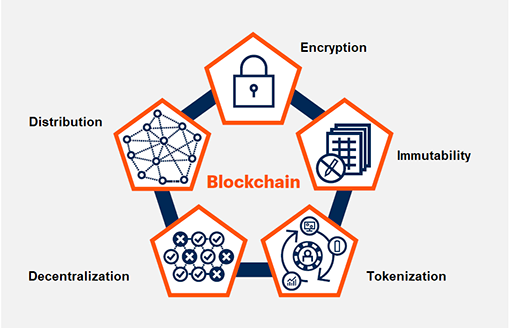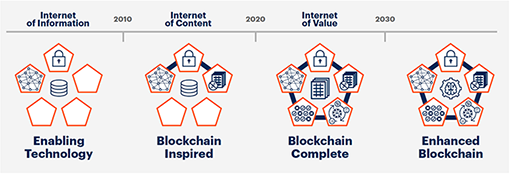The 4 Phases Of The Gartner Blockchain Spectrum

It’s easy to be swept up in the promise and hype of blockchain, but the reality is that most solutions marketed as “blockchain” are missing key components — particularly tokenization and decentralization. This “blockchain washing” creates confusion in the market for CIOs and business leaders as they assess the cost-benefit analysis of blockchain. The current picture is therefore incomplete and fails to address the evolving nature of blockchain technology.
“
Enterprises can easily make missteps that will leave them out of position to capitalize fully on blockchain
”
“When considering the use of blockchain, CIOs are in need of a model that can enable them to easily and accurately align the needs of their enterprise with the appropriate blockchain solution or alternate technology,” says David Furlonger, Distinguished VP Analyst and Gartner Fellow, Gartner. Gartner created the Blockchain Spectrum to examine the phased evolution of blockchain solutions and how this path aligns to the anticipated value businesses can derive. CIOs should not ignore this technology, just as they should not fall for vendors claiming to have complete blockchain solutions.
“Enterprises can easily make missteps that will leave them out of position to capitalize fully on blockchain by being lulled into a false sense of progress and capability,” says Christophe Uzureau, VP Analyst, Gartner.
What is blockchain?
Real blockchain contains five elements: Distribution, encryption, immutability, tokenization and decentralization. When combined, these elements enable organizations to take advantage of the true benefit of blockchain, which is allowing two or more parties who don’t know each other to safely interact in a digital environment and exchange new forms of value and assets.
The Gartner Blockchain Spectrum
The Blockchain Spectrum is made up of four archetypes broken down by the characteristics and elements they contain, some of which won’t fully develop for years. Each of these phases offers opportunities and risks, but CIOs should begin experimenting at some level.
Blockchain-enabling
These technologies provide the building block foundation upon which future blockchain solutions can be created. These blocks can also be used as part of nonblockchain solutions, for example, to improve the operational efficiency of distributed data management systems. The building blocks include cryptography, distributed computing, peer-to-peer networking and messaging.
Blockchain-inspired
Blockchain-inspired solutions use three of the five elements: Distribution, encryption and immutability. Generally, these solutions will lack tokenization and decentralization. This means they often focus on efficiency or reengineering existing processes. As an example, Alibaba tracks and traces food products from around the world. Blockchain-inspired solutions will dominate enterprise implementation focus through the early 2020s. These solutions are generally of limited scope and rely on maintaining establish processes and architecture such as a centralized notary, distributed or replicated data stores, hashing/signing and a messaging layer. Critically, they lack the ability to tokenize multiple forms of digital and nondigital assets and are designed without a basis for decentralized operations and governance.
Blockchain-complete
Beginning around 2023, enterprise-ready blockchain-complete solutions will emerge. These will utilize all five blockchain elements and offer a path to completely new business models that use dynamic smart contracts, tokenization and decentralized operational structures. These solutions will deliver on the full value proposition of blockchain. Blockchain-complete solutions will feature tokenization enabled by smart contracts and decentralization, two components blockchain-inspired solutions often lack.
These capabilities are the catalysts for the introduction of new business models. The introduction and use of blockchain-enabled tokens will allow for previously impossible value exchange systems, notably at a micro level. To distinguish these solutions from blockchain-inspired solutions, investigate how the technology is implemented; how the solution handles data; where the data controls sit; whether tokenization is an inherent design facet; how transaction governance is enabled; and how on-chain/off-chain data synchronization occurs.
Blockchain-enhanced
Moving into 2025, blockchain will incorporate complementary technologies, such as the Internet of Things (IoT), artificial intelligence (AI) and decentralized self-sovereign identity (SSI). This evolution will enable people to own, control and share their digital and nondigital identities via decentralized SSI. Individuals will be able to decide how their identities will be shared, leading to a situation when organizations, people or things can use that data as needed for an interaction. All the data will be secured, for example, in a digital wallet, and be traceable and trackable. These solutions will also expand the types of value that can be tokenized and increase the number of microtransactions enabled by smart contracts.
For example, this could lead to a car negotiating its own insurance rates directly with the insurance company based on data collected by the car’s sensors. Blockchain-enhanced solutions will lead to business model changes as autonomous agents gain the ability to commercially interact and operate independently of a human. CIOs should begin exploring and evaluating current market solutions as well as discussing the potential for massive shifts to the rest of the business.
This article has been updated from the original, published on January 22, 2019, to reflect new events, conditions or research.
![]()

